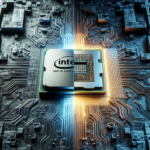The Difference Between Intel and AMD CPUs

Introduction
When it comes to choosing a central processing unit (CPU) for your computer, two names dominate the market: Intel and AMD. Both companies have a long history of producing high-quality processors, but they have different approaches, strengths, and weaknesses. This article aims to provide a comprehensive comparison between Intel and AMD CPUs, helping you make an informed decision based on your specific needs.
History and Background
Intel
Intel Corporation, founded in 1968, is one of the oldest and most influential technology companies in the world. Known for its innovation and leadership in semiconductor manufacturing, Intel has been a dominant force in the CPU market for decades. The company introduced the first microprocessor, the Intel 4004, in 1971, and has since continued to push the boundaries of computing technology.
AMD
Advanced Micro Devices (AMD) was founded in 1969, just a year after Intel. While AMD initially focused on producing memory chips, it soon shifted its focus to CPUs and has been a significant competitor to Intel ever since. AMD has a reputation for offering high-performance processors at competitive prices, making it a popular choice among budget-conscious consumers and gamers.
Architecture and Technology
Intel’s Architecture
Intel’s CPUs are known for their high clock speeds and strong single-threaded performance. The company uses a variety of architectures, including the well-known Core, Xeon, and Atom series. Intel’s processors are built using a monolithic design, which means that all cores and components are integrated into a single die. This design allows for efficient communication between cores but can be more challenging to manufacture at smaller process nodes.
AMD’s Architecture
AMD’s CPUs, particularly those in the Ryzen and EPYC series, use a chiplet-based design. This approach involves combining multiple smaller dies (chiplets) into a single package, which can improve manufacturing yields and reduce costs. AMD’s processors are known for their strong multi-threaded performance, thanks to their higher core and thread counts. The company’s Zen architecture has been particularly successful, offering significant performance improvements with each new generation.
Performance
Single-Threaded Performance
Single-threaded performance is crucial for tasks that rely on a single core, such as gaming and certain applications. Historically, Intel has had the edge in this area, thanks to its higher clock speeds and superior instructions per clock (IPC). However, AMD has made significant strides with its Zen architecture, closing the gap in single-threaded performance.
Multi-Threaded Performance
Multi-threaded performance is essential for tasks that can utilize multiple cores, such as video editing, 3D rendering, and scientific simulations. AMD’s Ryzen and EPYC processors excel in this area, thanks to their higher core and thread counts. Intel’s processors also offer strong multi-threaded performance, particularly in the high-end Xeon series, but AMD’s chiplet-based design gives it an advantage in terms of scalability and cost-effectiveness.
Power Consumption and Efficiency
Intel
Intel’s CPUs are known for their power efficiency, particularly in the mobile and low-power segments. The company’s 10nm and 14nm process nodes have allowed it to produce processors with excellent performance-per-watt ratios. However, Intel has faced challenges in moving to smaller process nodes, which has impacted its ability to compete with AMD in terms of power efficiency at the high end.
AMD
AMD’s use of TSMC’s 7nm and 5nm process nodes has given it a significant advantage in terms of power efficiency. The company’s Ryzen and EPYC processors offer excellent performance-per-watt ratios, making them a popular choice for energy-conscious consumers and data centers. AMD’s chiplet-based design also allows for more efficient power distribution, further enhancing its efficiency.
Price and Value
Intel
Intel’s CPUs are generally priced at a premium, reflecting the company’s strong brand reputation and high-performance offerings. While Intel’s processors offer excellent performance, they can be more expensive than comparable AMD models, particularly in the high-end and enthusiast segments.
AMD
AMD is known for offering competitive pricing, making its CPUs an attractive option for budget-conscious consumers and gamers. The company’s Ryzen processors, in particular, offer excellent performance at a lower price point than comparable Intel models. AMD’s aggressive pricing strategy has helped it gain market share and attract a loyal customer base.
Compatibility and Ecosystem
Intel
Intel has a well-established ecosystem, with strong support from motherboard manufacturers, software developers, and peripheral makers. The company’s CPUs are compatible with a wide range of motherboards, although Intel tends to change socket types more frequently than AMD, which can require more frequent upgrades.
AMD
AMD’s Ryzen processors use the AM4 socket, which has been in use since 2016. This long-term socket support has made it easier for consumers to upgrade their CPUs without needing to replace their motherboards. AMD also has strong support from motherboard manufacturers and software developers, making it a viable option for a wide range of applications.
Overclocking
Intel
Intel offers overclocking support on its K-series processors, which are designed for enthusiasts looking to push their CPUs beyond stock speeds. Intel’s processors are known for their high overclocking potential, thanks to their strong single-threaded performance and robust power delivery systems. However, overclocking can void warranties and requires adequate cooling solutions.
AMD
AMD’s Ryzen processors also support overclocking, with all Ryzen models offering unlocked multipliers. AMD’s Precision Boost and Precision Boost Overdrive technologies make it easier for users to achieve stable overclocks without extensive manual tuning. While AMD’s processors may not reach the same high clock speeds as Intel’s, they offer excellent multi-threaded performance and value for overclockers.
Integrated Graphics
Intel
Intel’s CPUs often come with integrated graphics, known as Intel UHD Graphics or Intel Iris Graphics. These integrated GPUs are suitable for basic tasks such as web browsing, video playback, and light gaming. Intel’s integrated graphics have improved significantly over the years, offering better performance and efficiency.
AMD
AMD’s Ryzen processors with integrated graphics are known as APUs (Accelerated Processing Units). These APUs feature Radeon Vega graphics, which offer superior performance compared to Intel’s integrated GPUs. AMD’s APUs are a popular choice for budget gaming builds and compact systems that don’t require a dedicated graphics card.
Market Segments
Consumer Desktop
In the consumer desktop market, both Intel and AMD offer a wide range of processors to suit different needs and budgets. Intel’s Core i3, i5, i7, and i9 series compete directly with AMD’s Ryzen 3, 5, 7, and 9 series. AMD’s Ryzen processors are known for their strong multi-threaded performance and value, while Intel’s Core processors excel in single-threaded tasks and gaming.
Gaming
For gaming, both Intel and AMD offer excellent options. Intel’s high clock speeds and strong single-threaded performance make its CPUs a popular choice for gamers. However, AMD’s Ryzen processors have closed the gap in gaming performance and offer better multi-threaded performance, making them a great choice for gamers who also engage in content creation or streaming.
Workstations and Content Creation
In the workstation and content creation market, AMD’s Ryzen Threadripper and EPYC processors offer exceptional multi-threaded performance, making them ideal for tasks such as video editing, 3D rendering, and scientific simulations. Intel’s Xeon processors also offer strong performance in this segment, but AMD’s higher core counts and competitive pricing give it an edge.
Servers and Data Centers
In the server and data center market, AMD’s EPYC processors have gained significant traction thanks to their high core counts, strong multi-threaded performance, and excellent power efficiency. Intel’s Xeon processors remain a popular choice, particularly for applications that require strong single-threaded performance and compatibility with existing infrastructure.
FAQ
Which CPU is better for gaming, Intel or AMD?
Both Intel and AMD offer excellent gaming CPUs. Intel’s high clock speeds and strong single-threaded performance make its CPUs a popular choice for gamers. However, AMD’s Ryzen processors have closed the gap in gaming performance and offer better multi-threaded performance, making them a great choice for gamers who also engage in content creation or streaming.
Are AMD CPUs more power-efficient than Intel CPUs?
AMD’s use of TSMC’s 7nm and 5nm process nodes has given it a significant advantage in terms of power efficiency. The company’s Ryzen and EPYC processors offer excellent performance-per-watt ratios. Intel’s CPUs are also known for their power efficiency, particularly in the mobile and low-power segments, but AMD has the edge in terms of power efficiency at the high end.
Can I overclock both Intel and AMD CPUs?
Yes, both Intel and AMD offer overclocking support on certain models. Intel’s K-series processors are designed for overclocking enthusiasts, while all AMD Ryzen processors come with unlocked multipliers. Overclocking can void warranties and requires adequate cooling solutions, so it’s essential to proceed with caution.
Do Intel CPUs have better integrated graphics than AMD CPUs?
Intel’s CPUs often come with integrated graphics, known as Intel UHD Graphics or Intel Iris Graphics, which are suitable for basic tasks and light gaming. However, AMD’s Ryzen processors with integrated graphics (APUs) feature Radeon Vega graphics, which offer superior performance compared to Intel’s integrated GPUs.
Which CPU brand offers better value for money?
AMD is known for offering competitive pricing, making its CPUs an attractive option for budget-conscious consumers and gamers. The company’s Ryzen processors offer excellent performance at a lower price point than comparable Intel models. Intel’s CPUs are generally priced at a premium, reflecting the company’s strong brand reputation and high-performance offerings.
Conclusion
Both Intel and AMD offer a wide range of CPUs to suit different needs and budgets. Intel’s processors are known for their high clock speeds, strong single-threaded performance, and power efficiency, making them a popular choice for gamers and mobile devices. AMD’s processors excel in multi-threaded performance, power efficiency, and value, making them ideal for content creation, workstations, and data centers.
Ultimately, the choice between Intel and AMD depends on your specific requirements and budget. By understanding the strengths and weaknesses of each brand, you can make an informed decision that best meets your needs.


